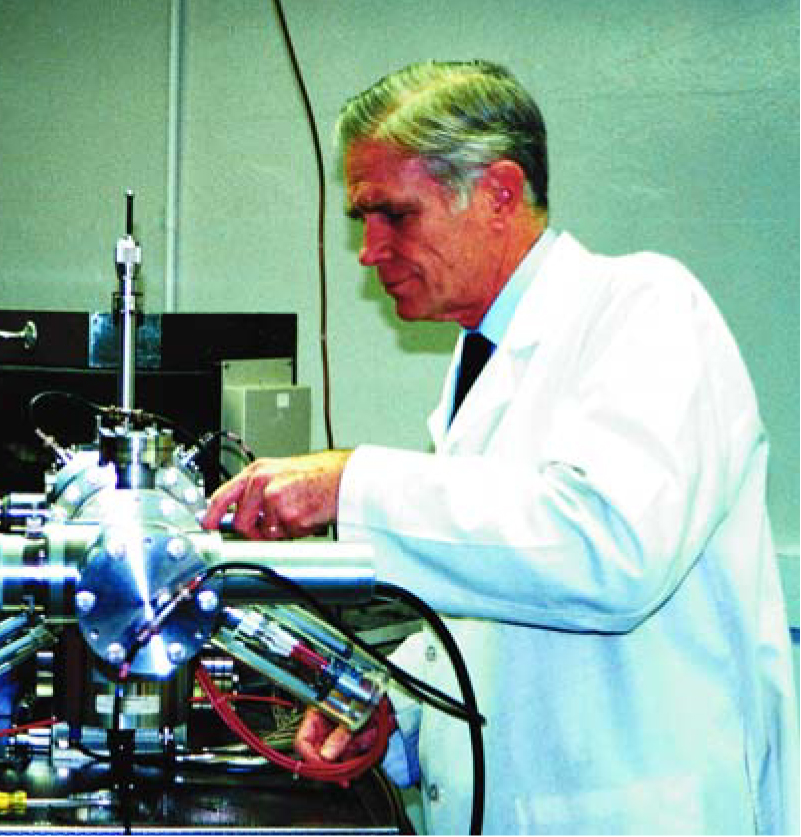Louis Brown
DOI: 10.1063/1.1955496
Physicist and historian Louis Brown of the Carnegie Institution of Washington’s Department of Terrestrial Magnetism (DTM) died from a heart attack on 25 September 2004 while he was leaving the opera in New York City. Lou had been an active researcher whose career spanned nuclear physics, the intersection of physics with isotope geology, and the history of science and military technology.
Born in San Angelo, Texas, on 7 January 1929, Lou studied physics at St. Mary’s University in San Antonio and received his BS in 1950. He spent the next two years as an artillery lieutenant in the US Army; he regarded his military service as an important part of his education. He completed his PhD in physics at the University of Texas at Austin in 1958.
Lou then accepted a postdoctoral position with the physics department of the University of Basel, Switzerland. He joined Hermann Rudin and one of us (Striebel) to design and build a source of polarized protons and deuterons for accelerator experiments in nuclear physics. The Basel team was the first to successfully produce a beam of polarized deuterons and won the university’s Amerbach Prize for that work.
In 1961, Lou returned to the US as a staff member at DTM under director Merle A. Tuve. There, Lou installed a polarized proton source that he had designed in Basel to improve on the team’s original effort. Until 1976, he directed Carnegie’s nuclear physics program in collaboration with scientists from Basel and the University of Wisconsin–Madison. Program researchers focused on interactions of polarized protons with light nuclei that are important in hydrogen-burning stars.
Lou’s wide intellectual curiosity and interest in novel instrumentation intersected with DTM’s use of isotope systems to study Earth and space. Working with Roy Middleton (see his obituary on page 85 of this issue) and Jeffrey Klein at the University of Pennsylvania, and Fouad Tera, Selwyn Sacks, and one of us (Morris) at DTM, Lou was central to the earliest development of accelerator mass spectrometry. In a 1982 paper in Nature, Lou and coauthors reported an exciting application of extraordinarily sensitive accelerator mass spectroscopy: They were the first to measure concentration levels at a million atoms per gram of cosmogenic beryllium-10 in volcanoes from the Ring of Fire. Before that time, 10Be was determined by beta-decay counting; new experiments elsewhere with cyclotron measurements had just begun. The method is now used worldwide for measuring many cosmogenic nuclides in biomedical, environmental, geological, meteoritic, and forensic samples. Lou published a series of papers exploring 10Be systematics and their utility in the Earth sciences. Throughout his career, Lou was involved in the design and construction of mass spectrometers and, shortly before his death, of an ion-microprobe mass spectrometer.
In the 1990s, Lou’s interests turned to writing history, particularly on the development of the proximity fuze during World War II and the invention of radar. He relished the worldwide contacts with old-time radar workers that developed as he wrote his magnum opus, A Radar History of World War II: Technical and Military Imperatives (IOP, 1999). The work was hailed for its encyclopedic breadth, its balance, and its international scope. As noted on the book’s back cover, Pulitzer Prize winner Richard Rhodes called it “a great book, of permanent value: powerful, magisterial, full of surprises and freighted with deep insight into science and human affairs.” Lou’s expertise was sought by curators at the Smithsonian Institution in Washington, DC, and at the Historical Electronics Museum in Baltimore, Maryland. As unofficial historian of DTM, he was instrumental in preserving the department’s archives and its historic field and laboratory photographs. Sadly, Lou did not live to see the culmination of that work in print, but the Centennial History of the Carnegie Institution of Washington. Volume II: The Department of Terrestrial Magnetism (Cambridge U. Press, 2005) is a lasting tribute to him.
A hallmark of Lou’s style was his joyful zest and vigor, both physical and intellectual. He was remarkably generous professionally, an attribute that led to many successful team collaborations, and he contributed unselfishly to the success of his younger colleagues. Lou’s plan was to retire at age 65 to make room for a younger scientist, and then keep working, which is exactly what he did. Many colleagues were inspired by his intellectual breadth and scientific enthusiasm, which never waned.


More about the Authors
Julie Morris. 1 Washington University, St. Louis, Missouri, US .
Hans Rudolf Striebel. 2 University of Basel, Basel, Switzerland .
Shaun Hardy. 3 Carnegie Institution of Washington, Washington, DC, US .
